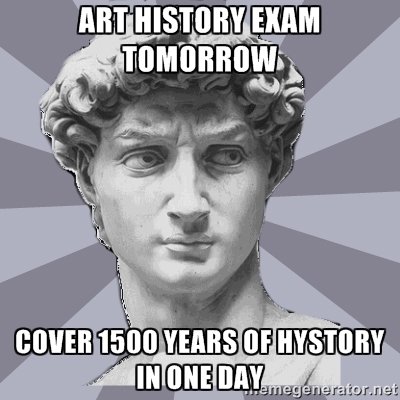So I had my first meeting about my ISM today, discussing what makes a videogame art, what might make it design instead, how different institutions have coped with the issues of displaying videogames in galleries and what makes a good videogame exhitbion.
In preparation for my meeting I was reading a book called The Art of Videogames. It says lots of interesting things, I’m sure there will be lots of blogs about the interesting things it says (and that other books say) in the future.
It discusses the idea (on page 186) that gaming criticism isn’t yet at the level of discussion needed to situate it within the wider understanding of culture and arts. It argues that videogame criticism is not advanced enough with it’s theoretical understanding of it’s place within the arts. That it needs to move from ‘game reviews’ into something more substantial.
The problem is, Tavinor suggests, that game reviews tend to revolve around a rather one-sided and ‘fanboy’ish account of the game. Hell, major developers have their own magazines that produce reviews of their games – you think they’re ever going to be honest? The fact is that in this kind of situation somebody has to pay the bills, and if you’re writing for a magazine it’s generally going to be the advertisers. And the advertisers in videogame magazines tend to be people with a vested interest in you giving their produce a good review. This doesn’t tend to happen in the art world (as a counter-example). The most respected reviews tend to be in national newspapers – they have their own political slant, but they’re rarely influenced by the backers that they have in quite the same was as, oh I don’t know, Nintendo Magazine. Even the glossy art magazines like Frieze are known for their unbiased editorial opinion, I’m not sure I can think of a gaming magazine that quite can say the same.
So you think to yourself that perhaps there will be some more meaty reviews on the internet, where people aren’t being influenced in the same way by advertisers. The problem here is that the fanboy culture is really, really strong and players will be loyal to a franchise or a design studio to the extreme. Fanboyism has seen a massive rise over the past decade or two, and one the places that is truly bad for it is within gaming. In addition the gaming community isn’t the most unbiased community in the world, but I’ll leave the #GamerGate remarks alone for fear of more rape threats.
You see, I read game reviews and I find them… dull. They often provide a good factual insight into the game. It has good playability, the shadows are rendered so well, the storyline isn’t quite so hot. It might tell you a bit about why this game is important or if it’s a new franchise or something.
Here’s a paragraph from the Gamespot review of the remastered Grim Fandango:
That isn’t to say Grim Fandango doesn’t harbor its minor annoyances. It’s easy, for instance, to walk into that elevator in Rubacava by accident when you wander too close and descend to ground level, only to have to get back in and rise again to the top. More relevant is the remastering itself, which might leave you disappointed in light of the dramatic visual transformations we see in remakes like Oddworld: New ‘n’ Tasty!, or remasters like Halo: Combat Evolved Anniversary. You can see the differences between the old version and the remaster with a click of a button, and you’ll note that environments and cutscenes haven’t changed in any meaningful way. Granted, Grim Fandango’s background art remains vibrant, but the new, smooth character models and shadows sometimes look out of place as a result. I often found myself sticking with the original models just because they looked more natural in front of the low-resolution backgrounds.
And here’s a paragraph from Brian Sewell’s review of the Matisse Cut-Outs exhibition:
Enjoy the gaiety of colour. Be moved by the myth of the old genius, victim of a botched stomach operation, discovering new inspiration when told that death was on his doorstep. Be astonished by this sensualist turned saint, finding God in his own work, lying a-bed and drawing on the wall with a six-foot pole, cluttering every surface with the worst drawings this worst of draughtsmen ever did. Delight in the jaunty amusements of the infants’ school, but do not discard your critical faculties. Is what you see in this Matisse really a match for Michelangelo’s Adam, his nude youths, his prophets and sybils, his Last Judgement? What nonsense.
I mean you could argue that one is a virtuoso and the other is just a game. Except that Grim Fandango is considered one of the greatest cultural videogames ever produced. It has warmth and genuine emotion while stick ticking all the gameplay boxes. It does things that other games still have not done. It was – and still is – groundbreaking. Like Matisse and his cut-outs.
Or you could argue that the target audience for videogames is not the kind of person who could easily read and understand the kind of language in the Sewell review. Except I feel that really does do a disservice to both art and videogames. You see, when we enjoy art we don’t have any other options. This is what we start with – the advanced stuff. If you want to know about an artist then your simplest text is probably Gombrich’s book which is aimed at the beginner. Except even that is aimed at an advanced A-Level audience really. There’s no reason to dumb a subject down, your audience will raise their game if they want to understand what you’re saying.
I fear I might be straying into dangerous territory here, but I can’t help wondering sometimes if that’s the nerdrage problem with people like Anita Sarkeesian. Is it because she uses long words and talks about concepts that are just not discussed within the gaming world?
I’m kind of reminded at this point of Mark Grist and his ‘I’d like a girl who reads’ poem. It seems so shameful to enjoy using expressive vocabulary and to enjoy reading it. I mean, could you imagine how much more exciting debates and experience would be if we ‘used our added vocabulary to hold lively conversations’ in every day life about gaming?
I mean, I just want to put another video here and I’d like you to compare the words of Mark Grist and Aukes. I find watching the rap battles that he participates in to be a real sobering experience to see what some people think is good use of language. ‘The structures that you’ve got are what’s covered back in preschool’ at 4 minutes or so.
I guess you could say that gamers just don’t want to discuss videogames at this level, but then why do so many gamers insist that gaming is indeed a cultural and worthwhile activity? You can’t have it both ways. You can’t argue that gaming is an cultural art form akin to film or music and then not apply the same kind of rigorous debate that these other art forms have. The language we use to talk about videogames needs to grow up if it wants to be accepted as part of the wider arts.
But this will only happen as more people study the intersection between culture and videogames and we develop the vocabulary required to talk about the artefacts in a meaningful way. There’s relatively few books written on the subject and those people have not generally gone through their education with a focus on this particular subject (of course I’m not saying that their books aren’t insightful and useful, it’s perfectly reasonable to jump across different interests in that situation) but the real game-changing texts will only start to come about when people emerge from the system having spent many years studying it.
Videogames are still new to academic writing, but it’s really exciting where it’s going. I’m already sold on the idea of videogames as art however I think that the surrounding culture – like reviews and critical discussion – needs to catch up before we can convince the public majority of this opinion.
(Got lost somewhere in the middle. It’s pre-0730hrs and I’ve not had enough caffeine. Might expand later.)


